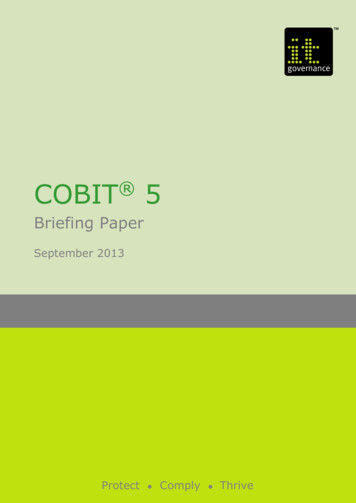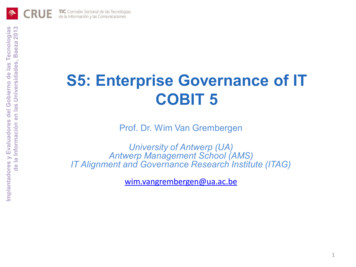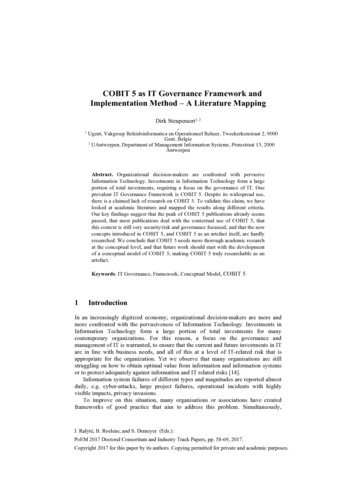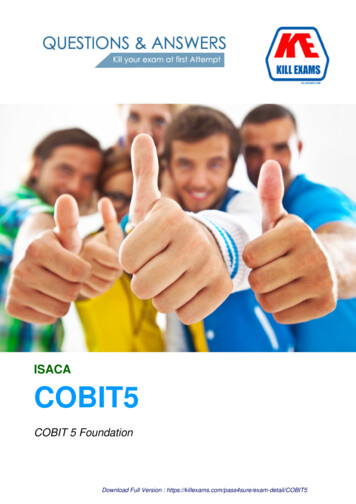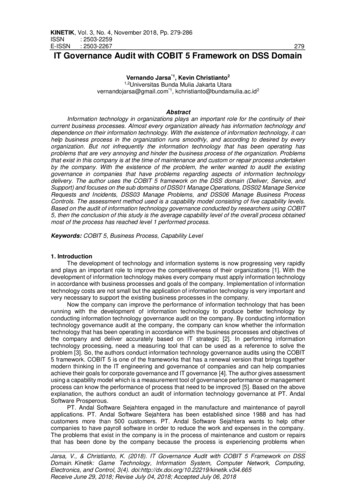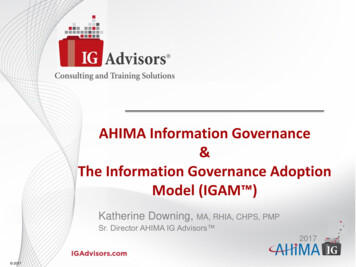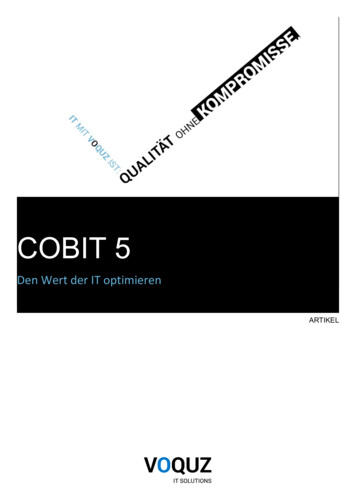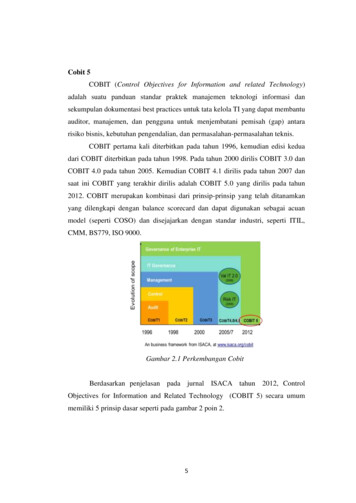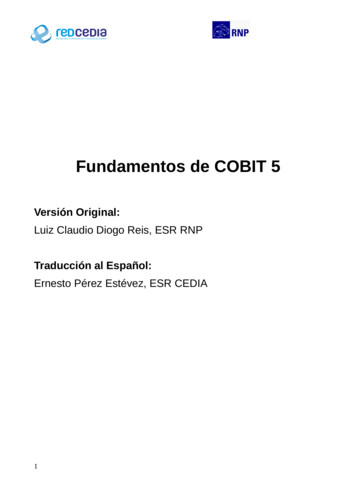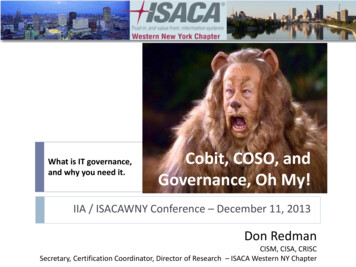
Transcription
What is IT governance,and why you need it.Cobit, COSO, andGovernance, Oh My!IIA / ISACAWNY Conference – December 11, 2013Don RedmanCISM, CISA, CRISCSecretary, Certification Coordinator, Director of Research – ISACA Western NY Chapter
Why Governance is important for Safe S-OXConsiders Enterprise objectives,Known variables, andRequirements of key stakeholdersEvaluates stakeholder needs through strategic planningSets direction and strategy through prioritized decision-makingProtects your vulnerable infrastructureMonitors performance and compliance, and progress againstagreed-on strategy and objectives But at the end of the day, It’s not as much fun as just getting the job done We don’t need no stinkin’ governance!2IT Governance - D. Redman – ISACA WNY11 Dec 2013
COSOInternal Control Integrated Framework3IT Governance - D. Redman – ISACA WNY11 Dec 2013
Why update what works – The Framework has become themost widely adopted control framework �s Internal Control–Integrated Framework (1992 Edition)Reflect changes inExpand operations andArticulate principles tobusiness & operatingreporting objectivesfacilitate pdatesContextinternal controlBroadens ApplicationClarifies RequirementsCOSO’s Internal Control–Integrated Framework (2013 Edition)Source: Internal Control Integrated Framework - www.coso.org4
Update expected to increase ease of use and broadenapplicationWhat is not changing.What is changing. Core definition of internal control Changes in business and operatingenvironments considered Three categories of objectives andfive components of internal control Each of the five components ofinternal control are required foreffective internal control Important role of judgment indesigning, implementing andconducting internal control, and inassessing its effectiveness Operations and reporting objectivesexpanded Fundamental concepts underlyingfive components articulated asprinciples Additional approaches andexamples relevant to operations,compliance, and non-financialreporting objectives addedSource: Internal Control Integrated Framework - www.coso.org5
Update considers changes in business and operatingenvironments have driven Framework updatesEnvironments changes.Expectations for governance oversightGlobalization of markets and operationsChanges and greater complexity in businessDemands and complexities in laws, rules,regulations, and standardsExpectations for competencies andaccountabilitiesUse of, and reliance on, evolving technologiesExpectations relating to preventing anddetecting fraudCOSO Cube (2013 Edition)Source: Internal Control Integrated Framework - www.coso.org6
Transition & Impact Users are encouraged to transition applications and related documentationto the updated Framework as soon as feasible Updated Framework will supersede original Framework at the end of thetransition period (i.e., December 15, 2014) During the transition period, external reporting should disclose whether theoriginal or updated version of the Framework was used Impact of adopting the updated Framework will vary by organization Does your system of internal control need to address changes in business? Does your system of internal control need to be updated to address all principles? Does your organization apply and interpret the original framework in the samemanner as COSO?– Is your organization considering new opportunities to apply internal control to coveradditional objectives?Source: Internal Control Integrated Framework - www.coso.org7
Transition & Impact (continued) The principles-based approach provides flexibility in applying theFramework to multiple, overlapping objectives across the entity– Easier to see what is covered and what is missing– Focus on principles may reduce likelihood of considering something that’sirrelevant Understanding the importance of specifying suitable objectives focuses onthose risks and controls most important to achieving these objectives. Focusing on areas of risk that exceed acceptance levels or need to bemanaged across the entity may reduce efforts spent mitigating risks inareas of lesser significance. Coordinating efforts for identifying and assessing risks across multiple,overlapping objectives may reduce the number of discrete risks assessedand mitigated.Source: Internal Control Integrated Framework - www.coso.org8
Transition & Impact (continued) Selecting, developing, and deploying controls to effect multiple principlesmay also reduce the number of discrete, layered-on controls. Applying an integrated approach to internal control - encompassingoperations, reporting, and compliance – may lessen complexity. In assessing severity of internal control deficiencies, use only the relevantclassification criteria as set out in the Framework or by regulators, standardsetting bodies, and other relevant third parties, as appropriate.Source: Internal Control Integrated Framework - www.coso.org9
COBIT 5Control Objectives forInformation and related Technology10IT Governance - D. Redman – ISACA WNY11 Dec 2013
What is your IT Governance Experience Index? Level 4 – Experienced Subject Matter Expert Level 3 – Have done some reading / learning “What is that light in the tunnel, an oncoming train?”Level 1 – Management says we have to “Lost in Information Overload”Level 2 – Just getting started “Just here for the BEER CPEs – I should have volunteered to teach this workshop.”“Deer in the headlights”Level 0 – Voted in the last governance election 11“Everyone stop picking on Affordable Health Care!”IT Governance - D. Redman – ISACA WNY11 Dec 2013
“I didn't have time to write a short letter, so I wrote a long one instead.” – Mark Twain
Information! Information is a key resource for all enterprises. Information is created, used, retained, disclosed anddestroyed. Technology plays a key role in these actions. Technology is becoming pervasive in all aspects ofbusiness and personal life.What benefits do information and technology bring toenterprises?13
Enterprise BenefitsEnterprises and their executives strive to: Maintain quality information to support businessdecisions. Generate business value from IT-enabled investments,i.e., achieve strategic goals and realise business benefitsthrough effective and innovative use of IT. Achieve operational excellence through reliable andefficient application of technology. Maintain IT-related risk at an acceptable level. Optimise the cost of IT services and technology.How can these benefits be realised to create enterprisestakeholder value?14
Stakeholder Value Delivering enterprise stakeholder value requires goodgovernance and management of information andtechnology (IT) assets. Enterprise boards, executives and management have toembrace IT like any other significant part of the business. External legal, regulatory and contractual compliancerequirements related to enterprise use of information andtechnology are increasing, threatening value if breached. COBIT 5 provides a comprehensive framework thatassists enterprises to achieve their goals and delivervalue through effective governance and management ofenterprise IT.15
The COBIT 5 Framework Simply stated, COBIT 5 helps enterprises create optimalvalue from IT by maintaining a balance betweenrealising benefits and optimising risk levels and resourceuse. COBIT 5 enables information and related technology tobe governed and managed in a holistic manner for theentire enterprise, taking in the full end-to-end businessand functional areas of responsibility, considering theIT-related interests of internal and externalstakeholders. The COBIT 5 principles and enablers are generic anduseful for enterprises of all sizes, whether commercial,not-for-profit or in the public sector.16
COBIT 5 PrinciplesSource: COBIT 5, figure 2. 2012 ISACA All rights reserved.17
COBIT 5 EnablersSource: COBIT 5, figure 12. 2012 ISACA All rights reserved.18
Governance and Management Governance ensures that enterprise objectives areachieved by evaluating stakeholder needs, conditionsand options; setting direction through prioritisation anddecision making; and monitoring performance,compliance and progress against agreed-on directionand objectives (EDM). Management plans, builds, runs and monitors activitiesin alignment with the direction set by the governancebody to achieve the enterprise objectives (PBRM).19
In Summary COBIT 5 brings together the five principles thatallow the enterprise to build an effectivegovernance and management framework basedon a holistic set of seven enablers that optimisesinformation and technology investment and usefor the benefit of stakeholders.20
COBIT 5: Now One CompleteBusiness Framework forEvolution of scopeGovernance of Enterprise ITIT GovernanceVal IT 2.0Management(2008)ControlRisk 0/4.1 COBIT 52005/72012An business framework from ISACA, at www.isaca.org/cobit 2012 ISACA All rights reserved.22
COBIT 5 FrameworkCOBIT 5: The main, overarching COBIT 5 product Contains the executive summary and the full description of allof the COBIT 5 framework components: The five COBIT 5 principles The seven COBIT 5 enablers plus An introduction to the implementation guidance providedby ISACA (COBIT 5 Implementation) An introduction to the COBIT Assessment Programme (notspecific to COBIT 5) and the process capability approachbeing adopted by ISACA for COBIT23
COBIT 5 Product FamilySource: COBIT 5, figure 11. 2012 ISACA All rights reserved.24
Five COBIT 5 PrinciplesThe five COBIT 5 principles:1. Meeting Stakeholder Needs2. Covering the Enterprise End-to-end3. Applying a Single Integrated Framework4. Enabling a Holistic Approach5. Separating Governance From Management25
1. Meeting Stakeholder NeedsPrinciple 1. Meeting Stakeholder Needs Enterprises exist to create value for their stakeholders.Source: COBIT 5, figure 3. 2012 ISACA All rights reserved.26
1. Meeting Stakeholder Needs(cont.)Principle 1. Meeting Stakeholder Needs: Enterprises have many stakeholders, and ‘creating value’means different—and sometimes conflicting—things toeach of them. Governance is about negotiating and deciding amongstdifferent stakeholders’ value interests. The governance system should consider all stakeholderswhen making benefit, resource and risk assessmentdecisions. For each decision, the following can and should be asked:- Who receives the benefits?- Who bears the risk?- What resources are required?27
1. Meeting Stakeholder Needs(cont.)Principle 1. Meeting StakeholderNeeds: Stakeholder needs have to betransformed into an enterprise’sactionable strategy. The COBIT 5 goals cascadetranslates stakeholder needsinto specific, actionable andcustomised goals within thecontext of the enterprise,IT-related goals and enablergoals.Source: COBIT 5, figure 4. 2012 ISACA All rights reserved.28
1. Meeting Stakeholder Needs(cont.)Principle 1. Meeting Stakeholder Needs:Benefits of the COBIT 5 goals cascade: It allows the definition of priorities for implementation,improvement and assurance of enterprise governance of ITbased on (strategic) objectives of the enterprise and therelated risk. In practice, the goals cascade: Defines relevant and tangible goals and objectives atvarious levels of responsibility. Filters the knowledge base of COBIT 5, based onenterprise goals to extract relevant guidance for inclusionin specific implementation, improvement or assuranceprojects. Clearly identifies and communicates how (sometimesvery operational) enablers are important to achieveenterprise goals.29
2. Covering the Enterprise End-to-endPrinciple 2. Covering the Enterprise End-to-end: COBIT 5 addresses the governance and management ofinformation and related technology from an enterprisewide,end-to-end perspective. This means that COBIT 5: Integrates governance of enterprise IT into enterprisegovernance, i.e., the governance system for enterprise ITproposed by COBIT 5 integrates seamlessly in anygovernance system because COBIT 5 aligns with thelatest views on governance. Covers all functions and processes within the enterprise;COBIT 5 does not focus only on the ‘IT function’, buttreats information and related technologies as assetsthat need to be dealt with just like any other asset byeveryone in the enterprise.30
2. Covering the Enterprise End-to-end (cont.)Principle 2. Covering the Enterprise End-to-endKey componentsof a governancesystemSource: COBIT 5, figure 8. 2012 ISACA All rights reserved.Source: COBIT 5, figure 9. 2012 ISACA All rights reserved.31
3. Applying a Single Integrated FrameworkPrinciple 3. Applying a Single Integrated Framework: COBIT 5 aligns with the latest relevant other standards andframeworks used by enterprises: Enterprise: COSO, COSO ERM, ISO/IEC 9000, ISO/IEC31000 IT-related: ISO/IEC 38500, ITIL, ISO/IEC 27000 series,TOGAF, PMBOK/PRINCE2, CMMI Etc. This allows the enterprise to use COBIT 5 as the overarchinggovernance and management framework integrator. ISACA plans a capability to facilitate COBIT user mapping ofpractices and activities to third-party references.32
4. Enabling a Holistic ApproachPrinciple 4. Enabling a Holistic ApproachCOBIT 5 enablers are: Factors that, individually and collectively, influencewhether something will work—in the case of COBIT,governance and management over enterprise IT Driven by the goals cascade, i.e., higher-level IT-relatedgoals define what the different enablers should achieve Described by the COBIT 5 framework in sevencategories33
4. Enabling a Holistic Approach (cont.)Principle 4. Enabling a Holistic ApproachSource: COBIT 5, figure 12. 2012 ISACA All rights reserved.34
4. Enabling a Holistic Approach (cont.)Principle 4. Enabling a Holistic Approach:1. Processes—Describe an organised set of practices and activities to achievecertain objectives and produce a set of outputs in support of achieving overallIT-related goals2. Organisational structures—Are the key decision-making entities in anorganisation3. Culture, ethics and behaviour—Of individuals and of the organisation; veryoften underestimated as a success factor in governance and managementactivities4. Principles, policies and frameworks—Are the vehicles to translate the desiredbehaviour into practical guidance for day-to-day management5. Information—Is pervasive throughout any organisation, i.e., deals with allinformation produced and used by the enterprise. Information is required forkeeping the organisation running and well governed, but at the operationallevel, information is very often the key product of the enterprise itself.6. Services, infrastructure and applications—Include the infrastructure,technology and applications that provide the enterprise with informationtechnology processing and services7. People, skills and competencies—Are linked to people and are required forsuccessful completion of all activities and for making correct decisions andtaking corrective actions35
4. Enabling a Holistic Approach (cont).Principle 4. Enabling a Holistic Approach: Systemic governance and management throughinterconnected enablers—To achieve the main objectives ofthe enterprise, it must always consider an interconnected setof enablers, i.e., each enabler: Needs the input of other enablers to be fully effective,e.g., processes need information, organisationalstructures need skills and behaviour Delivers output to the benefit of other enablers, e.g.,processes deliver information, skills and behaviour makeprocesses efficient This is a KEY principle emerging from the ISACA developmentwork around the Business Model for Information Security(BMIS).36
4. Enabling a Holistic Approach (cont).Principle 4. Enabling a Holistic ApproachCOBIT 5 Enabler Dimensions: All enablers have a set of common dimensions. This set of commondimensions: Provides a common, simple and structured way to deal with enablers Allows an entity to manage its complex interactions Facilitates successful outcomes of the enablersSource: COBIT 5, figure 13. 2012 ISACA All rights reserved.37
5. Separating Governance From ManagementPrinciple 5. Separating Governance From Management: The COBIT 5 framework makes a clear distinctionbetween governance and management. These two disciplines: Encompass different types of activities Require different organisational structures Serve different purposes Governance—In most enterprises, governance is theresponsibility of the board of directors under theleadership of the chairperson. Management—In most enterprises, management is theresponsibility of the executive management under theleadership of the CEO.38
5. Separating Governance From Management (cont.)Principle 5. Separating Governance FromManagement: Governance ensures that stakeholders needs,conditions and options are evaluated to determinebalanced, agreed-on enterprise objectives to beachieved; setting direction through prioritisation anddecision making; and monitoring performance andcompliance against agreed-on direction and objectives(EDM). Management plans, builds, runs and monitorsactivities in alignment with the direction set by thegovernance body to achieve the enterprise objectives(PBRM).39
5. Separating Governance From Management (cont.)Principle 5. Separating Governance From Management:COBIT 5 is not prescriptive, but it advocates that organisationsimplement governance and management processes such thatthe key areas are covered, as shown.Source: COBIT 5, figure 15. 2012 ISACA All rights reserved.40
5. Separating Governance From Management (cont.)Principle 5. Separating Governance from Management: The COBIT 5 framework describes seven categories ofenablers (Principle 4). Processes are one category. An enterprise can organise its processes as it sees fit, aslong as all necessary governance and managementobjectives are covered. Smaller enterprises may havefewer processes; larger and more complex enterprisesmay have many processes, all to cover the sameobjectives. COBIT 5 includes a process reference model (PRM),which defines and describes in detail a number ofgovernance and management processes. The details ofthis specific enabler model can be found in the COBIT 5:Enabling Processes volume.41
COBIT 5: Enabling Processes COBIT 5: Enabling Processes complements COBIT 5 andcontains a detailed reference guide to the processes thatare defined in the COBIT 5 process reference model: In Chapter 2, the COBIT 5 goals cascade is recapitulatedand complemented with a set of example metrics forthe enterprise goals and the IT-related goals. In Chapter 3, the COBIT 5 process model is explainedand its components defined. Chapter 4 shows the diagram of this process referencemodel. Chapter 5 contains the detailed process informationfor all 37 COBIT 5 processes in the process referencemodel.43
COBIT 5: Enabling Processes(cont.)Source: COBIT 5, figure 29. 2012 ISACA All rights reserved.44
COBIT 5: Enabling ProcessesSource: COBIT 5, figure 16. 2012 ISACA All rights reserved.(cont.)45
COBIT 5: Enabling Processes(Cont.)COBIT 5: Enabling Processes: The COBIT 5 process reference model subdivides the ITrelated practices and activities of the enterprise into twomain areas—governance and management— withmanagement further divided into domains of processes: The GOVERNANCE domain contains five governanceprocesses; within each process, evaluate, direct andmonitor (EDM) practices are defined. The four MANAGEMENT domains are in line with theresponsibility areas of plan, build, run and monitor(PBRM).46
COBIT 5 Implementation The improvement of the governance of enterprise IT(GEIT) is widely recognised by top management as anessential part of enterprise
Dec 11, 2013 · The COBIT 5 Framework Simply stated, COBIT 5 helps enterprises create optimal value from IT by maintaining a balance between realising benefits and optimising risk levels and resource use. COBIT
